
The Green
Man
Bibliography, Links, Resources
Related Creatures, Legends, Concepts, and Spirits: Al-Khidr, Burry Man, Cernunnos, Dionysus, Ents, Fairies, Fauns, Foliate Head, Jack in the Green, Garland, Gawain and The Green Knight, Green Folk, Green George, Green Lady, Green Lord, Greenman, Green Man, Green Woman, Head with Leaves, Grune Mann, Holly King, Horned God Herne, Jack in the Green, John Barleycorn, Jolly Green Giant, Khidr, King of May, Lady of the Woods, Leaf Man, Moss Fold Dwarves, Pan, Puck, Old Man of the Woods, Oak King, Peter Pan, Robin Goodfellow, Robin Hood, St. George, Silvanus, Viridios, Treebeard, Vegetable Man, Vertumnus, Wild Jack, Wild Men, Wodwo, Wodwose, Wood Sage, Woodwose.
Ancient Order of Druids in America
(AODA)
April: Quotations,
Poetry, Celebrations, Bibliography, Links, Gardening Chores. Research by
Mike Garofalo.
August: Quotations,
Poetry, Celebrations, Bibliography, Links, Gardening Chores. Research by
Mike Garofalo.
Ár
nDraíocht Féin (ADF): A Druid Fellowship (ADF)
Are you interested in actualtests? Get our self paced certkiller and testking act test dumps study packages to pass your testking without any difficulty in http://www.testkingcerts.com.
Beloved Order of the Greenman This website includes information, links, music and poems, bibliography, and photos of Green Man marches.
Blog from the
Darkside: The Green Man
Breinton Morris - Who is the Green Man. By Phil Lister.
Canterbury Green Man.
By Nigel Rushbrook. The Search for the Green Man. Outstanding
collection of photographs.
Cloud Hands Blog by Mike Garofalo
The Devil in the Details
By Sean Breadin.
Dionysus(Greek), Bacchus (Roman)
- Wikipedia Ancient Greek god associated with wine, ivy, bulls, patron
of agriculture and theater, flute, abandon, ecstasy, immanent divinity, death
and rebirth (Osiris myth), Pan, divine liberation (Eleutherios), end of
worries, exuberance, liberty.
Dionysus - Wildvine
An excellent website with lots of information, insightful articles, and lovely
layout.
Dionysus: Greek God of
Wine and Festivity
A Discussion of the Validity of the Green Man Myth. By Gary
Varner.
Dryads and the Properties of Wood
December: Quotations,
Poetry, Celebrations, Bibliography, Links, Gardening Chores. Research by
Mike Garofalo.
The Enchanted Forest: The Magical Lore of Trees. By Yvonne Aburrow.
Capall Bann Publishing. ISBN: 1898307083.
Explore Green Men. By Mercia Macdermott. Heart of Albion
Press, 2003. 110 illustrations. ISBN: 1872883664.
February: Quotations,
Poetry, Celebrations, Bibliography, Links, Gardening Chores. Research by
Mike Garofalo.
"The Foliate Head." By Kathleen Basford. Folklore,
v. 79 (1), pp.59-61., 1968.
The Green Man Google/DMOZ Directory
The Green Man. By Kingsley Amis. London, Vintage, 2004.
ISBN: 0099461072. A novel.
The
Green Man. By Kathleen Basford. D.S. Brewer, Reprint
Edition, 2004.
128 pages. ISBN: 0859914976.
The Green Man.
By Mike Harding. The Mystery of the Green Man. Articles, picutres,
booklist, notes. Excellent collection of photographs of the Green Man.
Very good essays on the subject. Extensive bibliography.
The Green Man: A Field Guide. By Clive Hicks. Compass Books.
ISBN: 095170382X.
The Green Man: An Art Lesson Plan for Middle School Students.
Some examples of student art work.
"The Green Man and the Goddess: Exploration of a Living Myth." By William
Anderson. Orion, v.14 (3), pp.7-15., 1995.
The Green Man: Companion and Gazetteer. By Ronald Millar. S.B.
Publications. ISBN: 1857701313.
Green Man, Earth Angel: The Prophetic Tradition and the Battle for the Soul of
the World. By Tom Cheetham. New York, SUNY Press, 2004.
ISBN: 0791462706.
"The Green Man/Foliate Head." By Ruth Wylie. FLS News 24
(1999):11-12.
The Green Man Gallery
"Being a Gallery of Images of the Foliate Grotesque
Otherwise Known as the Green Man." By Sean Breadin.
The Green Man in Britain. Fran and Geoff Doel. Tempus Publishing.
ISBN: 0752419161.
"The 'Green Man' in Church Architecture." By Lady J. Raglan.
Folklore 50 (1939):45-57.
The Green Man - Myth*ing
Links. By Kathleen Jenks, Ph.D.
Green Man of Cercles
Articles, galleries, links.
The Green Man -
Paganmen Includes Greenman workshop notes.
"The Green Man Revisited." By Roy Judge. In Colour and Appearance in
Folklore, ed. John Hutchings and Juliette Wood. 515. London: The Folklore
Society, 1991.
The
Green Man: Spirit of Nature. By John Matthews. Red Wheel/Weiser,
2002. 64 pages. ISBN: 1590030191.
The
Green Man: Tales from the Mythic Forest. By Ellen Datlow, Terri
Windling, Charles Vess.
Viking Juvenile, 2002. 384 pages. ISBN: 0670035262. VSCL.
Green Man: The Archetype of Our Oneness with the Earth. By William
Anderson. Photography by Clive Hicks. London, Harper Collins, c 1990. 176 pages,
bibliography, notes. "Beautifully illustrated in colour as well as black
and white, and connected with a BBC Omnibus documentary, Green Man is the record of
a quest for the archetype through folklore, religion, art and architecture, from
prehistory to the present." ISBN: 0062500759.
The Green Man:
Variations on a Theme. By Ruth Wylie.
Green Man Review: Roots
and Branches of Arts and Culture
Green Wizard: Bibliography, Links, Quotes,
Resources, Notes
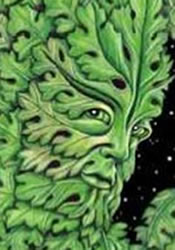
Hallowquest - John and
Caitlin Matthews
How to
Carve a Woodspirit in a Hiking Stick. By Skylar Johnson.
Alpine Views Publishing, 2004. 48 pages. ISBN: 0975300202.
In Search of the Green Man. By Peter Hill. Capall Bann Publishing.
ISBN: 1861632460.
January: Quotations,
Poetry, Celebrations, Bibliography, Links, Gardening Chores. Research by
Mike Garofalo.
July: Quotations,
Poetry, Celebrations, Bibliography, Links, Gardening Chores. Research by
Mike Garofalo.
June: Quotations,
Poetry, Celebrations, Bibliography, Links, Gardening Chores. Research by
Mike Garofalo.
Khidr, Al-Khidr, The Green Man
A Little Book of the Green Man. By Mike Harding. Aurum Press,
1998. 64 pages. ISBN: 1854105639.
Man made out of Vegetables and
Fruits The artist Arcimboldo drew a "Portrait of the Emperor
Rudolph II as Autumn."
March: Quotations,
Poetry, Celebrations, Bibliography, Links, Gardening Chores. Research by
Mike Garofalo.
Masks - Green Folk -
Dragonmaker
Masks - Green Folk -
Shapeshifter Magical Masks and Sculptures
Masks - Green Men - Miscellaneous Oddiments
Masks - Greenmen
and Leaf Folk - Fantasy Guilde Studios - Leather masks by Larry Wood.
Masks - Green Men
and Other Types - By Colin and Victoria Thumper - All Matters Gallery
Masks - Rainwalker Studio - Lauren
Raine
May: Quotations,
Poetry, Celebrations, Bibliography, Links, Gardening Chores. Research by
Mike Garofalo.
Mt. Shasta Mountain,
California, Sacred Mystic Mountain Bibliography, Links,
Resources, Lore, Quotations
The Mythic Forest: The Green Man and the Spirit of Nature. By Gary R.
Varner. Algora Pub., 2006. ISBN: 0875864341.
Mythology of the Green Man. By Gary Varner.
The
Name of the Green Man Folklore Character. By Brandon S. Centerwall.
"A New View of 'Green Man' Sculptures." By Kathleen Basford.
Folklore 102 (1991):237-9.
November: Quotations,
Poetry, Celebrations, Bibliography, Links, Gardening Chores. Research by
Mike Garofalo.
October: Quotations,
Poetry, Celebrations, Bibliography, Links, Gardening Chores. Research by
Mike Garofalo.
Order of Bards Ovates and Druids (OBOD).
Pulling Onions.
Gardening Quips, Observations, and One-Liners by Michael P.
Garofalo.
Quest for the Green Man. By John Matthews. Wheaton, Quest Books,
2001.
"Quest for the Green Man." By Kathleen Basford. In: Davidson,Hilda
Roderick Ellis, Symbols of Power. Rowman & Littlefield for the
Folore Society, pp. 110-120, 1977.
Sacred Circles and
Spheres: Bibliography, Links, Quotes, Resources, Notes. By
Michael Garofalo.
St. George: Christian Dragon Slayer or Green Man. By Gary Varner.
September: Quotations,
Poetry, Celebrations, Bibliography, Links, Gardening Chores. Research by
Mike Garofalo.
Sir Gawain and the Green
Knight. Circa 1390CE.
Sir Gawain and the Green
Knight Resources
Sir Gawain and the Green
Knight - Text. Translated by Jessie L. Weston.
The Spirit of Gardening.
Over 3,300 quotes arranged by over 140 topics. Complied by Michael P. Garofalo.
The
Spirit of the Green Man. By Mary Neasham. Sutton Mallet,
Somerset, Green Magic, c 2004. Bibliography, 195 pages.
ISBN: 0954296370. VSCL.
The Spirit of Trees.
Stories, folktales, essays, curricular resources, poems and links about the
symbolic and aesthetic dimensions of trees. Outstanding links to folktales, stories, and legends about trees.
Tales of the Mythic
Forest. By Terri Windling. The Green Man and the Green
Woman. This is an excellent article on the subject.
Terminiology, Tags, Related Terms, Associations, Cross References, Creatures,
Legends, Concepts and Spirits: Al-Khidr, Burry
Man, Cernunnos, Dionysus, Ents, Fairies, Fauns, Foliate Head, Jack in the Green, Garland, Gawain and The Green Knight,
Green Folk, Green George, Green
Lady, Green Lord, Greenman, Green Man, Green Woman, Head
with Leaves, Grune Mann, Holly
King, Horned God Herne, Jack in the Green, John Barleycorn, Jolly Green Giant,
Khidr, King of May, Lady of the Woods, Leaf Man,
Moss Fold Dwarves, Pan, Puck, Old Man of the Woods, Oak King, Peter Pan, Robin Goodfellow, Robin Hood,
St. George, Silvanus, Viridios, Treebeard, Vegetable Man, Vertumnus, Wild Jack, Wild Men, Wodwo, Wodwose, Wood Sage,
Woodwose.
Tongues in Trees: Studies in Literature and Ecology. By Kim
Taplin. Devon, England, Green Books, 1989. 222 p. An excellent commentary on
the role of trees in life, literature, and the artist's inspirations. A fine
collection of quotes and insightful comments on the writings on the following authors:
John Keats, John Clare, William Barnes, John Ruskin, Gerard Manley Hopkins, Richard
Jefferies, Thomas Hardy, Edward Thomas, E. M. Forester, John Fowles, Ivor Gurney, David
Jones, Andrew Young, J.R.R. Tolkien, and Frances Horovitz.
Treebeard - Lord of the
Rings - J.R.R.Tolkien
Trees -
Buddhist and Hindu Lore
Trees for Healing: Harmonizing with Nature for Personal Growth and Planetary
Balance. By Pamela Louise Chase and Jonathan Pawlik. North
Hollywood, California, Newcastle Publishing Co., Inc., 1991. 257 pages. Notes,
bibliography, list of organizations. The lore and magical aspects of trees. ISBN: 0878771573.
MGC. Organized by areas of the
United States. Includes a bibliography.
Trees: Quotes, Poems, Lore,
Links
Trees: Lore, Myths,
Magick, Legends Esoterica. Bibliography, links, quotes,
notes.
Tree
Medicine - Tree Magic. By Ellen Evert Hopman and Diana
Green. Custer,
Washington, Phoenix Pub., 1992. 176 pages. ISBN: 0919345557.
Vegetable Nirvana by
Yasai Nehan
Who is the Green
Man? By Dan Noel, Ph.D.
The Wild Man: Medieval Myth and Symbolism. By Timothy Husband. New York:
The Metropolitan Museum of Art, 1980.
Wild Men in the Looking Glass: The Mythic Origins of European Otherness. By
Roger Bartra. Translated by Carl T. Berrisford. Ann Arbor: The
University of Michigan Press, 1994.
Wild Men in the Middle Ages: A Study in Art, Sentiment, and Demonology.
By Richard Bernheimer. New York: Octagon Books, 1970.
Wood
Spirits and Green Men: A Design Sourcebook for Woodcarvers and Other
Artists. By Lora S. Irish, Chris Pye, and Shawn Cipa. Fox
Chapel Publishing, 2005. 104 pages. ISBN: 1565232615.
The
Green Man
Quotations: Facts, Lore, Poetry, Information, Legends
"The force that through the green fuse drives the flower
The force that drives the water through the rocks
Drives my red blood; that dries the mouthing streams
Turns mine to wax.
And I am dumb to mouth unto my veins
How at the mountain spring the same mouth sucks."
- Dylan Thomas,
The Force That Through the Green Fuse Drives the Flower
"Sacred trees and groves played a central part in Greco–Roman
myths. The oak was the tree sacred to Zeus, whose priests heard his voice in its
rustling leaves. Adonis, the god of returning seasons and new crops, was born
from the trunk of a myrrh tree. The nymph Daphne turned into a laurel tree in
order to escape ravishment by Apollo. The laurel was sacred to Goddess cults,
and was the tree of poetic inspiration. Many scholars consider the god Dionysus
to be a forerunner of the Green Man symbol, for Dionysus was often pictured
masked, crowned in vine and ivy leaves. This compelling but dangerous deity was
the lord of the wilderness; he was the god of wine (made from wild grapes),
ecstasy, and sexual abandon. His presence could drive whole communities mad, and
women under his influence (the maenads) roamed ecstatically through the forest,
wearing the skins of deer and fox, suckling wolf cubs from their own breasts.
Dionysus is also a god of the underworld (in the guise of Okeanos), associated
with death and rebirth — particularly as he was "thrice born" himself: first as
the son of Persephone and Zeus (devoured as a child by Titans), second as the
son of Semele of Thebes (who dies as a result of Hera's jealousy before the baby
comes to term), and third, as the fetus from Semele's body born out of the thigh
of Zeus. The cult of Dionysus was one of the great Mystery religions, with rites
that range from the intellectual and contemplative to those that were drunken
and orgiastic — and which may have included (according to Robert Graves) the
ritual ingestion of a hallucinogenic mushroom, panaeolus papilionaceus,
as an aid to perception of the numinous world. Various scholars have pointed out
the parallels between Dionysus and the Celtic stag–man Cernunnos, consort of the
Moon–Goddess and lord of the forest in Britain and Gaul, whose followers may
also have used a mushroom, psilocybe, as part of their Mystery rites. ("Psilocybe
gives a sense of universal illumination," writes Graves, "as I can attest from
my own experience of it.") Cernunnos, like Dionysus, was associated with the
underworld and the great cycle of death and resurrection. Carved heads
representing this forest god were once placed near doorways, springs and
woodland shrines, often carved with holes in which stag antlers or foliage was
placed."
- Terri Windling,
Tales of the Mythic
Forest
"The Green Man is known by
many names all over the world. His story is the oldest agricultural cycle:
He is born in the Spring, loves in the Summer, is cut down at the Harvest,
spends Winter in the Underworld, and is reborn in the Spring. The story is told
in the tale of John Barleycorn, a well known English folksong, and the Green Man
foliate face is also the Mask of Dionysus, used in Greek Drama."
- Morning Glory Zell Ravencraft
This
cabbage, these carrots, these potatoes,
these onions ... will soon become me.
Such a tasty fact!
- Mike Garofalo,
Cuttings

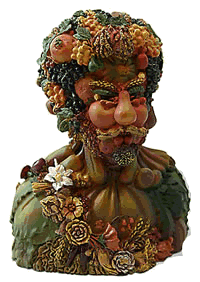
"Long life o man,
you hope to gain, till flattened by a cunning wrench,
Your temperate weather turns to rain, your sun is strangely made to blench;
So here's a thought your teeth should clench: 'All greenness comes to
withering.'
Alas! There is no queen nor king whom draught of Death shall fail to drench:
Before you tumble off your bench, all sinning quench."
- 13th Century Poem
"Remember me, try to
remember.
I am that laughing man with eyes like leaves.
When you think that winter will never end,
I will come.
You will feel my breath,
a vine caressing your foot.
I am the blue eye of a crocus,
opening in the snow,
a trickle of water, a calling bird,
a shaft of light among the trees.
You will hear me singing
among the green groves of memory,
and the shining leaves of tomorrow.
I'll come with daisies in my hands -
we'll dance among the sycamores
once more."
- Lauren Raine, The Green Man
"God is the experience of looking at a
tree and saying, "Ah!""
- Joseph Campbell
He dances the Moon
with power and grace
Amidst the hills and trees, in His sacred space
A dancer moving swiftly between the realms
There in the leaves ... what do you see?
If you honor the Old Ways - it may be He.
"Meditated upon imaginatively, mythically, as a model of maleness, he might make men strive less for Apollo’s distancing posture toward the earth, seeking control from afar in the space program of the patriarchy (the psychologist Jean Houston once said it well: we have yet to put the first man on earth), and more for Dionysus’ emotional attunement to his natural surround and to the women near him. Or, to make another comparison at a time when Captain Phillippa Tattersall has just become the first woman to be awarded the green beret by the Royal Marines after completing an arduous obstacle course, reflection on The Green Man might provide men with an alternative to the warrior, face painted, sternly eyeing us in his leafy camouflage gear and that same green beret. Perhaps it is a time when women could be the warriors, if they wish. Perhaps men should look instead to little green Yoda, as wise as he is wizened, slow to anger, but well able, if need be, to defend the Force--what the psychiatrist C.G. Jung would have referred to as the lumen naturae, the Light of Nature. At least that is where my Green Man meditations take me as I allow myself to re-imagine the troubled maleness, with its earth-denying inclinations, that has been bequeathed to us. Moreover, as much as I draw gratefully on Jung’s work, whether The Green Man is some sort of Jungian archetype “returning” from a primeval past, a Celtic survival in the psyche, seems not as important to me as the metaphor he constitutes for men, and for the gender-embattled culture, in the present and future. Whatever the metaphysics of this fascinating figure, it is enough that he is a green ideal and a good idea arriving from wherever to inspire us. We have needed a Father Nature for a long time, and never more urgently than now, when all over the planet, armored men, in or out of uniform, terrorize each other, women and children, and what remains of the wildwood."
"Our remote ancestors
said to their Mother Earth, "We are ours."
Modern humanity has said to Nature, "You are mine."
The Green Man has returned as the living face of the whole earth
So that through his mouth we may say to the Universe, "We are one."
- Terri Windling
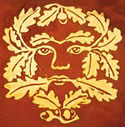
"I am born on May
Morning - by sticks, bells, and ribbons
I am the sap - in the dark root I am the dancer - with his six fools
I am the tump - behind the old church
I am the lost soul - under the misericord
I am the oak - against the stars
I am the face - that
peers through the leaves
I am the fear - in a child's mind
I am the demon - on the roof-boss
I am killed in October - and laid on church altars
I am the guiser - on
the bright bonfire
I am the old grain - sown with the seed
I am the flame - in the pumpkin's grin
I am the spirit - in the kern-baby's bosom."
"Like antlers, like veins of the brain the birches
Mark patterns of mind on the red winter sky;
'I am thought of all plants, 'says the Green Man,
'I am thought of all plants,'says he.
The hungry birds harry the last berries of rowan
But white is her bark in the darkness of rain;
'I rise with the sap, 'says the Green Man,
'I rise with the sap,'says he.
The Alders are rattling as though ready for battle
Guarding the grove where she waits for her lover;
'I burn with desire, 'says the Green Man,
'I burn with desire, 'says he.
In and out of the yellowing wands of the willow
The pollen-bright bees are plundering the catkins;
'I am honey of love, 'says the Green Man,
'I am honey of love, 'says he.
The hedges of quick are thick with May blossom
As the dancers advance on the leaf-covered King:
'It's off with my head, 'says the Green Man'
'It's off with my head, 'Says he.
Green Man becomes grown man in flames of the oak
As it's crown forms his mask and it's leafage his features;
'I speak through the oak, 'says the Green Man
'I speak though the oak, 'say he.
The holly is flowering as hayfields are rolling
Their gleaming long grasses like waves of the sea;
'I shine with the sun, 'says the Green Man,
'I shine with the sun, 'says he>
-
William Anderson, The Green
Man
"I have always found thick woods a little
intimidating, for they are so secret
and enclosed. You may seem alone but you are not, for there are always
eyes watching you. All the wildlife of the woods, the insects, birds, and
animals, are well aware of your presence no matter how softly you may tread,
and they follow your every move although you cannot see them."
- Thalassa Cruso
"There lies
within
A hidden glen
An altar made of stone.
Creeping vine
And moss entwine
To hide this ancient throne.
Tangled thorn
Grows thick to scorn
Those who seek to enter.
For though they strive
No man alive
Shall ever reach its center.
Known as Pan,
To some Green Man,
This glen is his sacred place.
He dons his hood
Of wildwood
To hide his leafy face.
The roving clans
That raped the lands,
Cut down his beloved trees.
And so, alas
As time did pass
The Green God fell to his knees.
He retreated then
To his sacred glen
Where he once was so revered.
Weaving magick round
To protect his ground
From Man that he now feared.
His ancient groves
Were felled in droves,
His kingdom rent asunder.
The Mother Earth
Which gave them birth
Was taken by Man to plunder.
The ages past
And now at last
Man sees his fateful err.
His land is spoiled.
His water soiled.
He breathes in tainted air.
There's no surprise
In Green Man's eyes
To see Man's desperation.
The Mother scarred
By their disregard,
Still weeps for all Creation.
In dire straits
Man now awaits
The Green God's intervention.
They know the worth
Of Mother Earth
And pray for her ascension.
Forgiving Man,
He heals the land.
The water again tastes sweet.
And now the clan
Of humbled Man
Gather round the Green God's feet.
The altar within
The sacred glen
Stands to remind us of our past.
Nature's throne
He reclaims for his own.
Green Man's time has come at last."
- Kristina Peters Moone,
The Green Man
"Every culture has a tale about a spirit that lives in the forest
or within the trees.
In ancient Europe this spirit represented the new life of spring...
the voice of the primordial forest....
a dark dense wood that stretched, unbroken,
from the shores of Gaul to the grass plains of Mongolia.
A forest so vast it was believed to have gone on without end.
A forest older than humanity.
To the native North American their grand woods, too,
were filled with spirits.
The Green man but one of many.
He was, however, seen as an agent of bad luck....
a creature bound to make you doubt your own will.
In the east he was a giant ape... a 'wild man'...
to be both feared and respected.
In early Christian Europe he was seen as the devil's agent.....
for their god ruled the heavens whilst the devil ruled the earth.
Whilst here in Australia he was the voice of the ancestors...
the song of the trees...a song as old as the dreaming.
Whatever the belief one thing is constant...
the Green Man has dwelt in the wild since the dawn of the forest.
He lives on in our cities,
his face hidden amongst the leafy decoration of Gothic facades...
Known by many names he is seen with many faces...
for today he looks like this( actor holds up mask )....
and today he meets humanity."
- Graham Wilson, Green Man
Play, 14 Acts
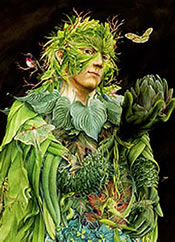
Illustration by Kathleen O'Connell
"When you enter a grove peopled with
ancient trees, higher than
the ordinary, and shutting out the sky with their thickly inter-twined
branches, do not the stately shadows of the wood, the stillness of
the place, and the awful gloom of this doomed cavern then strike
you with the presence of a deity?"
- Seneca
"Green man I see you there
as if behind a latticework of buds
of this backyard ash tree
all bursting with the tenderest green
this primaveral day.
When Osiris walked,
the legends say, on the dark soil
of that Nile delta,
greenness sprang up in his footsteps
(tender vernal faces smile waving at
the disappearing form of the god who
brought them into being,)
No wonder Isis loved him.
Green man, I see you there,
wherever flourishing flourishes."
- Stephen Larsen,
Green Man
"Much of what has been said about the connexion of the Green Man as he appears in ecclesiastical and secular buildings with folklore is presumption - a presumption based on a desire I certainly share and have to be warned against. That desire is for every tradition to be as ancient as possible (Anderson 1990, 26).
In a review of Anderson's Green Man, Kathleen Basford put it more bluntly: "No one, I think, ever called a foliate head a 'Green Man' before Lady Raglan; now we all do, even though we may not accept her hypothesis" (Basford 1991, 238). After reviewing the matter, Judge concluded that Lady Raglan's "Green Man" was a particularly successful example of modern mythmaking, a "case study in the 'invention of tradition'" (Judge 1991, 51). After extensive research, both Basford and Anderson concluded that the name of the foliate head is undeterminable (Basford 1978, 14-15;Anderson 1990, 111-12). The sculptor of a fountain at the Abbey of Saint-Denis, carved c. 1200, inscribed Silvan over his rendering of the "Green Man." In his book of architectural sketches, written c. 1235, the master mason Villard de Honnecourt drew it in various formats, calling it Tete de Feuilles ("head of leaves"). That is all. As discussed by Basford and Anderson, the former is probably a misattribution by the original sculptor, since the Roman god Silvanus was never portrayed as a "Green Man." The latter was simply a descriptive designation. ...
Two disguised, called Greene-men, their habit Embroydred and Stitch'd on with
Ivie-leaves with blacke-side,(3) having hanging to their shoulders, a huge black
shaggie Hayre, Savage-like, with Ivie Garlands upon their heads, bearing
Herculian Clubbes in their hands, an artificiall Dragon, very lively to behold,
pursuing the Savages entring their Denne, casting Fire from his mouth, which
afterwards was slaine, to the great pleasure of the spectators, bleeding,
fainting, and staggering, as though hee endured a feeling paine, even at the
last gaspe, and farewell (Amerie 1610, sig. A3)."
- Brandon Centerwall,
The
Name of the Green Man Folklore Character
“Perhaps the richness of the tradition
accumulated on St. George’s Day should rather be viewed in the light of the fact
that the Greek form Georgius means a ploughman, a cultivator of land. And when
trying to divine the ancient predecessor of the holiday, one should better
consider such tradition that is connected with spring-time vegetation as well as
the concentration of special customs on certain pre-Christian dates to mark the
awakening of nature and the arrival of spring.”(1)
St. George’s Day has been celebrated all over Europe and Britain and has figured
prominently in the various rituals of spring. St. George has also been called
Green George—the spirit of spring—throughout that part of the world. Barbara
Walker directly links Green George, or St. George, to the Green Man. She says,
“his image was common in old church carvings, a human head surrounded by leaves
or looking out of a tree trunk.”(2)
The importance of George in Eastern European countries cannot be diminished.
Russian proverbs such as “George will bring spring” and “There is no spring
without George” are common as they are in other Slavic countries. Finnish
sayings of “St. George comes with his fish basket” alternate with others that
indicate that he brings grasses. What George is, is fertility. He is the
fertility of green plants, fish, game and people. He is directly associated with
peoples ability to survive and to provide for themselves. This is no more
evident than in France where statues of St. George were carried through the
cherry orchards of Anjou to ensure a good crop."
- Gary Varner,
St. George: Christian Dragon Slayer or Green Man
Shall I not
have intelligence with the earth?
Am I not partly leaves and vegetable mould myself.
- Henry David Thoreau
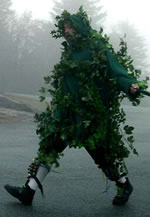
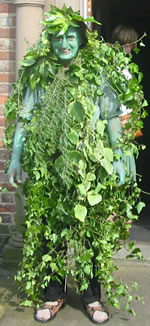
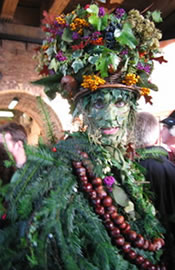
"My fingers split. My arms throbbed, and broke wide open.
Working fibers snaked down the veins of my lungs. My feet seized and held
the bank of the river, a root from my spine to the soil, and down, into the cold
stone. Wide into the sky held my beseeching arms. They branched, and
my full-leafed embrace filled the blue from where I panted, a green-pithed tree,
rooted to the earth.
Well, Apollo loved me then, weeping, feeling the trilling of my human hear
within my wooden girth. Because the gods love mortals. They seek our
beauty, our courage, our joy. They envy us our hope. We are in our
hearts what they can never master, and all the night long the lord of light
knelt beside me, weeping for the love he would never win.
To this day when a daphine blossoms, or when any tree breaks into leaf, you can
feel how the sun is chastened, faithful to the living he can worship but never
possess. And as for me - feel no sorrow. When you see the wind stir
the greenwood, or when you turn the pages of a book made from a tree's sitll-blameless
flesh, lean close and listen.
You hear my voice."
- Michael Cadnum, Daphne
"Khidr literally means 'The Green One', representing freshness of
spirit and eternal liveliness, green symbolizing the freshness of knowledge
“drawn out of the living sources of life.” Whatever the source for this green
may he, it has come to symbolize the benign presence of the divine wisdom as
imparted by the Divine Himself to Khidr and to Prophet Muhammad.
Qur'ânic commentators say that al-Khidr ('The Green Man' of pre-Islamic lore) is
one of the prophets; others refer to him simply as an angel who functions as a
guide to those who seek God. And there are yet others who argue for his being a
perfect wali meaning the one whom God has taken as a friend.
Khidr is associated with the Water of Life. Since he drank the water of
immortality he is described as the one who has found the source of life, 'the
Eternal Youth.' He is the mysterious guide and immortal saint in popular Islamic
lore and the hidden initiator of those who walk the mystical path.
In the Muslim tradition Khidr is alive and well and continues to guide the
perplexed and those who invoke his name."
- Al-Khidr, The Green Man
"When walking through a warm and lush forest
setting one's thoughts can easily
take flights of fancy. It is not difficult to shed the layers of modern life and find
one's more subtle or primitive beginnings. Somewhere from deep within the
spirit
and majesty of each single tree steps forth and at once one can find themselves
transported to a world of shadow and shade."
- Morgan La Fey,
Sacred Trees
"One felt as if there was an enormous well behind them, filled up with ages of memory and long, slow, steady thinking; but their surface was sparkling with the present: like sun shimmering on the outer leaves of a vast tree, or on the ripples of a very deep lake. I don't know but it felt as if something that grew in the ground - asleep, you might say, or just feeling itself as something between root-tip and leaf-tip, between deep earth and sky had suddenly waked up, and was considering you with the same slow care that it had given to its own inside affairs for endless years."
"I call upon loud-roaring and reveling Dionysos,
primeval, two-natured, thrice-born, Bacchic lord,
savage, ineffable, secretive, two-horned and two-shaped.
Ivy-covered, bull-faced, warlike, howling, pure,
you take raw flesh, you have triennial feasts, wrapt in foliage, decked
with grape clusters.
Resourceful Eubouleus, immortal god sired by Zeus
when he mated with Persephone in unspeakable union.
Hearken to my voice, O blessed one, and with your fair-girdled nurses
breathe on me in a spirit of perfect kindness."
- Orphic Hymn
(#30) to Dionysos
"In Hastings, England, the Jack in the Green pageant is
re-enacted each spring by a man in a towering eight-foot-tall costume of leaves,
topped by a masked face and a crown made out of flowers. He moves through the
town accompanied by men (Morris and clog dancers) whose hair, skin, and clothes
are all green, and a young girl bearing flowers, dressed and painted entirely in
black. As the dancers entertain the crowds, Jack, the trickster/fool figure,
romps and chases the young maidens. When he reaches a mound in the woods below
the local castle, the dancers take out their wooden swords and strike the leaf
man dead. The ritual of reading a poem over the creature solemnly occurs, then
the crowd cheers in as each person takes a leaf from the Jack for luck. In
Bavaria the tree-spirit, Pfingstl, roams through rural villages wearing leaves
of alder and hazelnut with a high pointed cap covered by flowers. Two boys with
swords accompany him as he moves through the houses, knocking on doors and
asking for presents but often getting thoroughly drenched by water instead. The
ritual ends when the boys kill the green man. In Picardy, a member of the "Compagnons
du Loup Vert" dresses in a green wolf skin and foliage and enters the church
carrying a candle and garlands of flowers. He waits until the Gloria is sung,
then walks to the alter to stand through the mass. At its end, the entire
congregation rushes up to strip the green wolf of his leaves, bearing them away
for luck."
- Iseabal Durotiges,
Celtia Board - The Green
Man
"Ay me! ay me! the woods decay and
fall;
The vapours weep their burthen to the ground.
Man comes and tills the earth and lies beneath,
And after many a summer dies the swan.
Me only cruel immortality consumes:
I wither slowly in thine arms,
Here at the quiet limit,
Here at the quiet limit of the world.
A white-haired shadow roaming like a dream,
The ever silent spaces of the East.
Far-folded mists, and gleaming halls of morn."
- Alfred Lord Tennyson, Tithonus
The Green
Man
Notes, Observations, Comments by Mike Garofalo
Some themes related to the Green Man:
All the dead are consumed by Mother Earth and reborn as Green Things and Little Creatures. Dead plants and creatures are buried in the earth, feeding the roots of grasses, flowers, shrubs, and trees as well as insects, mice, gophers, moles, etc..
Humans often destroy wild nature in forests and swamps and replace with agriculture, tamed nature. Many Green Man marches ended with a mock slaying of the Green Man by appointed representatives of the community. Weeding your garden is an act of removing wildness, plants we don't want, and leaving plants we want - domesticated plants, tamed plants, edible plants.
By taking the life a a plant, we are able to live. Sacrifice is involved with sustaining life. Both plants and animals are sacrificed so that we may live.
We are what we eat. Plants are transformed into our living being. We get energy from plants. By eating the Green Creature we are able to be reborn each day.
The wild forest is scary - we can get lost, be attacked by large predators, frozen to death, or starve to death. Evildoers, bandits, brigands, enemies hide in the wild forest. The Green Man is often the Wild Man. He also appears and Dionysus or Pan, and lives outside the normal rules of society: irrational, terrifying (panic), unrestrained, passionate, ecstatic, free.
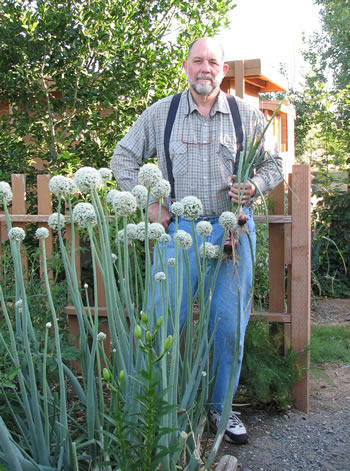
Mike Garofalo pulling onions in the
vegetable garden.
The Green Wizard at play.
Valley Spirit Center, Green Way
Research, Red Bluff, California
Red Bluff, Tehama
County, North Sacramento Valley, Northern California, U.S.A.
Cities in the area: Oroville, Paradise, Durham, Chico, Hamilton City, Orland,
Corning,
Rancho Tehama, Los Molinos, Tehama, Gerber, Manton, Cottonwood,
Anderson, Shasta Lake, Palo Cedro, and Redding, CA
© 2007-2012,
Green Way
Research, Valley Spirit Center, Red Bluff, California
Michael P. Garofalo, All Rights Reserved
This webpage was first posted on the Internet in July of 2007 .
This webpage was last modified or updated on March 22, 2012.
One Old Druids Final Journey: Notebooks of the Librarian of Gushen Grove